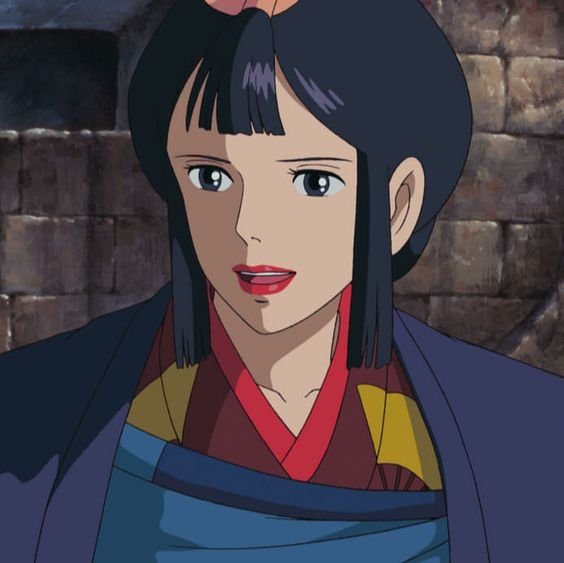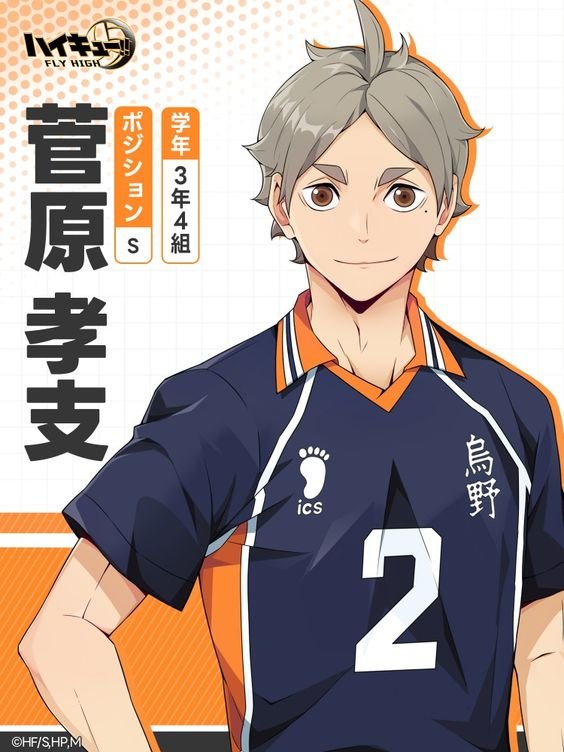
Lady Eboshi
Lady Eboshi |
|
|---|---|
 |
|
| Japanese Name: | エボシ御前 (Eboshi Gozen) |
| Species: | Human |
| Gender: | Female |
| First Appearance: | Princess Mononoke |
| Role: | Antagonist |
| Voice actor (Japanese): | Yūko Tanaka |
| Voice actor (Disney): | Minnie Driver |
Appearance

Lady Eboshi’s full appearance.
Lady Eboshi is characterized by her striking black hair, which she styles in a traditional manner secured with a pink ribbon. Notably, she is the only female character in the film who wears lipstick, adding to her commanding presence. Her clothing consists of dark red hakama, a type of male kimono, layered with a large cloak draped elegantly over her shoulders. This ensemble is reminiscent of shirabyōshi, a historical style associated with women performers, subtly hinting at her complex backstory and past experiences.
Eboshi’s attire reflects both her authority and her warrior spirit. When preparing for battle, she dons a shorter cloak and a distinctive red eboshi cap, which not only signifies her rank but also lends her character its name. This transformation into battle attire underscores her dual nature as both a leader and a fierce combatant, emphasizing her determination and strength as she faces her adversaries.
Personality
Lady Eboshi is a formidable and self-assured leader, driven by a vision to enact positive change in her world. As the head of Irontown, she is well-respected and beloved by her townspeople, who credit her with liberating them from oppressive circumstances. Among her most commendable achievements is her decision to rescue women from brothels, offering them a chance for a new life, and providing care and employment for lepers, who play crucial roles in her iron production efforts. This progressive agenda highlights her desire to uplift marginalized individuals, demonstrating a commitment to empowerment.
Despite her admirable intentions, Eboshi holds a dismissive view of the spirits and creatures of the forest, considering them naive and foolish. This perspective contributes to her portrayal as a morally ambiguous character, as she prioritizes human advancement at the expense of nature.
In moments of crisis, Lady Eboshi exhibits a calm and composed demeanor, a trait that underscores her leadership abilities. Her authoritative presence is palpable, often leading to tension with characters like Ashitaka, who challenge her worldview. She embodies the struggles of women in a patriarchal society, understanding the injustices they face and striving to create a space where they can thrive.
However, her ambition comes with consequences. Following the destruction of Irontown, a flicker of remorse is evident in her character, revealing her complexity and the weight of her choices. This duality makes Lady Eboshi a compelling figure in Princess Mononoke, illustrating the challenges of balancing progress and environmental preservation.
Past
Lady Eboshi’s history is marked by a series of dramatic transformations. Initially, she was a shirabyōshi, a female entertainer known for her dance and song. However, her life took a perilous turn when she was captured and held hostage by a group of pirates. During this tumultuous period, she became the wife of the pirate leader. Among the crew was Gonza, who was enamored with Eboshi despite his limitations, notably his inability to swim, hinting at his former life as a pirate.
Eboshi’s cunning nature surfaced when she plotted a rebellion with Gonza. In a bold move, she assassinated her husband, liberating herself from the clutches of piracy. Following her escape, she became fascinated by the power of firearms and sought to enhance her arsenal. By importing advanced Chinese guns and modernizing them, she fortified her position and expanded her influence, ultimately leading her to seize control of the Cedar Forest.
This complex past shaped Lady Eboshi into the ambitious and determined leader she is in Princess Mononoke, revealing her resilience and the lengths she will go to achieve her goals.
Plot
Lady Eboshi makes her first appearance leading her army as they transport rice to Irontown. During this journey, her convoy is ambushed by San and her pack of wolves, but they manage to fend off the attack. When Ashitaka arrives in Irontown, he quickly encounters Eboshi and learns about her role in the transformation of Nago, the boar god, into a vengeful demon.
Tensions escalate when San infiltrates Irontown with the intent to confront Eboshi. The conflict culminates in a fierce battle where San decapitates the Forest Spirit, resulting in devastating consequences. In the chaos, Moro, the wolf goddess and San’s adoptive mother, bites off Eboshi’s right arm, a pivotal moment that symbolizes the fierce struggle between humanity and nature.
Ultimately, after the land has been rejuvenated, Eboshi expresses her commitment to rebuild Irontown into a better place, vowing to respect the forest and its inhabitants moving forward. This promise signifies a shift in her character, reflecting the lessons learned through the tumultuous events.